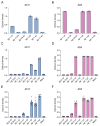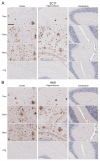Novel Monoclonal Antibody Specific toward Amyloid-β Binds to a Unique Epitope within the N-Terminal Region
- PMID: 39189239
- PMCID: PMC11348109
- DOI: 10.3390/antib13030068
Novel Monoclonal Antibody Specific toward Amyloid-β Binds to a Unique Epitope within the N-Terminal Region
Abstract
Amyloid-β (Aβ) deposition throughout the neuroaxis is a classical hallmark of several neurodegenerative diseases, most notably Alzheimer's disease (AD). Aβ peptides of varied length and diverse structural conformations are deposited within the parenchyma and vasculature in the brains of individuals with AD. Neuropathologically, Aβ pathology can be assessed using antibodies to label and characterize their features, which in turn leads to a more extensive understanding of the pathological process. In the present study, we generated a novel monoclonal antibody, which we found to be specific for the N-terminal region of Aβ. This antibody reacted to amyloid precursor protein expressed in cultured cells and labels Aβ plaques and cerebral amyloid angiopathy in brain tissue from a mouse model of amyloidosis as well as post-mortem brain tissue from patients diagnosed with AD. This highly specific novel antibody will serve as a unique tool for future studies investigating Aβ deposition in novel mouse models and cross-sectional studies using post-mortem human tissue.
Keywords: Alzheimer’s disease; Amyloid-β; antibody; pathology; plaques.
Conflict of interest statement
The authors declare no conflict of interest.
Figures





Similar articles
-
Phosphorylated Aβ peptides in human Down syndrome brain and different Alzheimer's-like mouse models.Acta Neuropathol Commun. 2020 Jul 29;8(1):118. doi: 10.1186/s40478-020-00959-w. Acta Neuropathol Commun. 2020. PMID: 32727580 Free PMC article.
-
Novel Phosphorylation-State Specific Antibodies Reveal Differential Deposition of Ser26 Phosphorylated Aβ Species in a Mouse Model of Alzheimer's Disease.Front Mol Neurosci. 2021 Jan 15;13:619639. doi: 10.3389/fnmol.2020.619639. eCollection 2020. Front Mol Neurosci. 2021. PMID: 33519377 Free PMC article.
-
Targeting isoaspartate-modified Aβ rescues behavioral deficits in transgenic mice with Alzheimer's disease-like pathology.Alzheimers Res Ther. 2020 Nov 14;12(1):149. doi: 10.1186/s13195-020-00719-x. Alzheimers Res Ther. 2020. PMID: 33189132 Free PMC article.
-
Alzheimer's disease.Subcell Biochem. 2012;65:329-52. doi: 10.1007/978-94-007-5416-4_14. Subcell Biochem. 2012. PMID: 23225010 Review.
-
Distribution of beta/A4 protein and amyloid precursor protein in hereditary cerebral hemorrhage with amyloidosis-Dutch type and Alzheimer's disease.Am J Pathol. 1993 May;142(5):1449-57. Am J Pathol. 1993. PMID: 7684195 Free PMC article. Review.
References
-
- McKhann G.M., Knopman D.S., Chertkow H., Hyman B.T., Jack C.R., Kawas C.H., Klunk W.E., Koroshetz W.J., Manly J.J., Mayeux R., et al. The Diagnosis of Dementia Due to Alzheimer’s Disease: Recommendations from the National Institute on Aging-Alzheimer’s Association Workgroups on Diagnostic Guidelines for Alzheimer’s Disease. Alzheimers Dement. 2011;7:263–269. doi: 10.1016/j.jalz.2011.03.005. - DOI - PMC - PubMed
-
- Braak H., Alafuzoff I., Arzberger T., Kretzschmar H., Del Tredici K., Alafuzov I., Arzberger T., Kretzschmar H., Del Tredici K. Staging of Alzheimer Disease-Associated Neurofibrillary Pathology Using Paraffin Sections and Immunocytochemistry. Acta Neuropathol. 2006;112:389–404. doi: 10.1007/s00401-006-0127-z. - DOI - PMC - PubMed
Grants and funding
LinkOut - more resources
Full Text Sources

